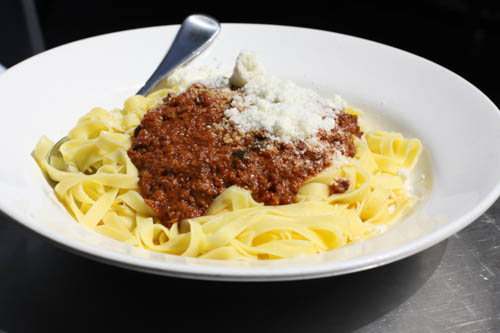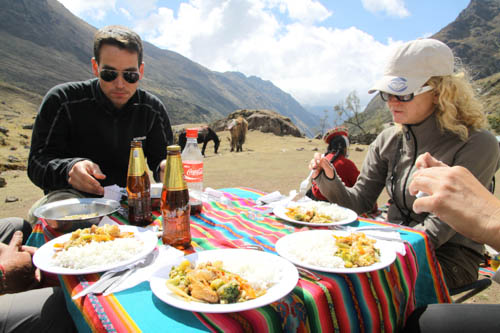Food and identity: other factors
 Saturday, April 26, 2014 at 2:04PM
Saturday, April 26, 2014 at 2:04PM  When I first started reading about food and identity I used to gloss over the parts which highlighted the role played by factors such as globalisation and commercialisation. I wasn’t interested in this. I liked reading about the sentimental stuff. But the more I have read, the harder it has been to ignore and now that I am going to be writing my dissertation on the subject I can’t afford to overlook it.
When I first started reading about food and identity I used to gloss over the parts which highlighted the role played by factors such as globalisation and commercialisation. I wasn’t interested in this. I liked reading about the sentimental stuff. But the more I have read, the harder it has been to ignore and now that I am going to be writing my dissertation on the subject I can’t afford to overlook it.
Funnily enough, when I was writing about my own food memories in my last post I started writing about my childhood obsession with English junk food and realised that, subconsciously, I had been influenced by these other factors. I loved stocking up on English junk food on childhood visits to the UK from Australia. I was keen on the ‘Olde' English hard-boiled sweets that you couldn’t get in Oz, but I was also interested in the different brands and flavours of crisps and sweets available. I thought it novel that the colours of crisp packets indicated different flavours in the UK. When I was back in Australia last Christmas, I found some old journals from my trips to England. I had actually stuck the empty crisp and chocolate wrappers in them, along with ticket stubs, postcards and other ‘memories’.

Kids are perhaps particularly susceptible to marketing. Jun Jing (2000) and Guo Yuhua (2000), who both look at cultural factors shaping children’s diets in China, highlight the influence of market forces on children. With China’s move to a market economy and greater trade with the outside world, children have become increasingly influenced by new, imported and luxury foods, especially snacks and soft drinks. Interestingly, Yuhua suggests that children are often influenced by wrappers and packaging, rather than taste (Phew! It’s not just me). In schools, consuming the most popular brands has become a mark of status. The food companies are well aware of this and capitalise on it, using celebrities to market products, offering loyalty schemes (for example, branded t-shirts in exchange for tokens) and associating their products with ‘visions of a good life’.

Children are highly impressionable, but adults are also susceptible to marketing. For example, parents in Yuhua’s and Jing’s studies were influenced not only by their children, but by health claims made by the companies. However, I am interested here in the more subtle, indirect ways in which processes, such as globalisation and commercialisation, affect the way that adults identify with certain foods.
In my last post I focused on the links between food and national identity in the context of migration. I touched briefly on the idea that boundaries, for example between local, regional and national, are difficult to draw in reality. This is as relevant to cuisines as people. Is there such a thing as national cuisine? Richard Wilk (2002) and Sidney Mintz, (1996) are sceptical about this. Mintz argues that it makes more sense to talk of regional cuisines. Even those cuisines that seem the most coherent and easy to define, like Italian and French, can be seen as a compilation of dishes and styles of cooking taken from various regional cuisines, which are perhaps more easily defined.

Nonetheless, people in the ethnographic studies I have looked at still make reference to foods that they perceive to be part of a national cuisine, which suggests that it is important. But why? The cynical answer is that it is driven, at least to a certain extent, by the processes I have been talking about: marketing, consumer culture, globalisation and commercialisation.
Wilk (2002: 69) presents an interesting case study of Belize, “one of the least likely places where you would expect to find a national cuisine”. When the colony was established, the traditional Mayan culture had already been largely destroyed and Belize has since been populated almost entirely by immigrants. These people brought their own food cultures, but had to adapt to the foodstuffs available, which included exotic tropical produce and imports from Europe. Wilk (2002: 79) argues that during the colonial period Belizeans developed foodways that provided the basis for a ‘self-conscious’ national cuisine, but that in practice “the nation’s food practices appear to be heterogenous, polyglot, disorderly and even incoherent.”

Public debate and discourse around national food in Belize started in the 1960s and became more entrenched in the 1980s. Wilk suggests three reasons for this – migration, tourism and the media. As Belizeans migrated to other parts of the world they yearned for the foods that reminded them of home. Expats in America set up Belizean restaurants serving Belizean beer and generic Caribbean dishes. What is particularly interesting is that Belizean restaurants in the US preceded those in Belize itself.
Wilk argues that in the context of migration, ethnic cooking tends to be simplified somewhat, with a focus on a few emblematic dishes. When some migrants returned to Belize they brought their notion of a national cuisine with them. In the 1990s the first Belizean restaurant opened in Belize. More followed, as they became popular with tourists. Overtime, foreign visitors played a role in defining Belizean cuisine too, both through their demand for an ‘authentic’, ‘local’ experience and also through the media, writing magazine and newspaper articles on the subject.
“To summarize, one version of national food was developed in America by Belizeans for Americans; another was developed partly by Americans in Belize, for Belizeans; [and] a third version of Belizean food [was] developed by Belizean and foreign entrepreneurs to feed foreign tourists with a taste for something authentically Belizean.” (Wilk, 2002: 84)
Wilk is less cynical than me about the processes of globalisation, suggesting that it has been going on for centuries and the whole idea of local food is questionable in any case. His argument is convincing, something I was not yet ready to admit when I first read it. Instead, I focused on Wilk’s own admission that Belize is a unique case.
However, I have since read several other articles that have changed my mind. For example, Adrian Peace (2011) highlights how 'imaginative discourses' around food and drink in the Barossa Valley, Australia, make exaggerated claims about heritage, tradition and history to endow ‘local’ food culture with authenticity. In the Barossa, such ‘cultural myths’ and ‘invented traditions’ are produced to feed a booming tourist and wine industry which, given its transnational nature, is anything but local.
A regional or national cuisine is now seen as important part of the ‘cultural capital’ of a place or nation. Governments often support or actively lead the development of national cuisines as part of their nation-building projects (Ayora-Diaz, 2010; Cusack, 2000; Karaosmanoğlu, 2007; Pilcher, 1998). In terms of the role of commercialisation, I was particularly surprised to read Jeffery Pilcher’s (2002) account of how Pepsi has been incorporated into ritual life of Tzotzil Indians in San Juan Chamula, Mexico. Apparently, it has replaced wine in church services and is thought to ward off evil spirits and cleanse the soul!

So what are my thoughts on all this now? At a personal or local level, I do think there is a genuine desire to identify with cuisines, be they local, regional or national. These links seem to become particularly significant when people migrate, as they feel nostalgia for things that remind them of home. But all I have read has now convinced me that how people identify with certain foods is not simply down to individual choice or personal experience. Government, private institutions, producers and consumers all play a role in defining cuisines and the way that we identify with them, as do various media, such as TV, newspapers, cookbooks and guidebooks.
Food is a way of bringing people together, but it is also a way of signifying difference. In carving out a space on the global stage, it has become increasingly important to highlight uniqueness. With food, as with other commodities, tradition is particularly highly valued. Personally, I have begun to think twice when I read the words ‘heritage’, ‘heirloom’ or ‘history'.

References
Ayora-Diaz, S. I. 2010. Regionalism and the Institution of the Yucatecan Gastronomic Field. Food, Culture and Society: An International Journal of Multidisciplinary Research, 13(3), 397-420.
Cusack, I. 2000. African Cuisines: Recipes for Nation-Building? Journal of African Cultural Studies, 13(2), 207-225.
Jing, J. 2000. Food, Nutrition and Cultural Authority in a Gansu Village. In Jun Jing (ed.). Feeding China’s Little Emperors: Food, Children, and Social Change. Stanford: Stanford University Press, 135-159.
Karaosmanoğlu, D. 2007. Surviving the Global Market: Turkish Cuisine Under Construction. Food, Culture and Society: An International Journal of MultidisciplinaryResearch, 10(3), 425-448.
Mintz, S. 1996.Tasting Food, Tasting Freedom: Excursions in to Eating, Culture and the Past. Boston: Beacon Press.
Peace, A. 2011. Barossa Dreaming: Imagining Place and Constituting Cuisine in Contemporary Australia. Anthropological Forum: A Journal of Social Anthropology and Comparative Sociology, 21(1), 23-42.
Pilcher, J. M. 1998. ¡Que Vivan los Tamales! Food and the Making of Mexican Identity. Albuquerque: University of New Mexico Press.
Pilcher, J.M. 2002. Industrial Tortillas and Folkloric Pepsi: The Nutritional Consequences of Hybrid Cuisines in Mexico. In W. Belasco and P. Scranton, eds. Food Nations: Selling Taste in Consumer Societies. New York: Routledge, 222-239.
Wilk, R. 2002. Food and nationalism: the origins of ‘Belizean Food’. In W. Belasco and P. Scranton eds. Food Nations: Selling Taste in Consumer Societies. London: Routledge, 67-89.
Yuhua, G. 2000. Food and Family Relations: The Generation Gap at the Table. In Jun Jing (ed.). Feeding China’s Little Emperors: Food, Children, and Social Change. Stanford: Stanford University Press, 135-159.
 Vix |
Vix |  Post a Comment |
Post a Comment |  commercialisation,
commercialisation,  cuisine,
cuisine,  foodways,
foodways,  globalisation,
globalisation,  national identity in
national identity in  Identity
Identity 
Reader Comments